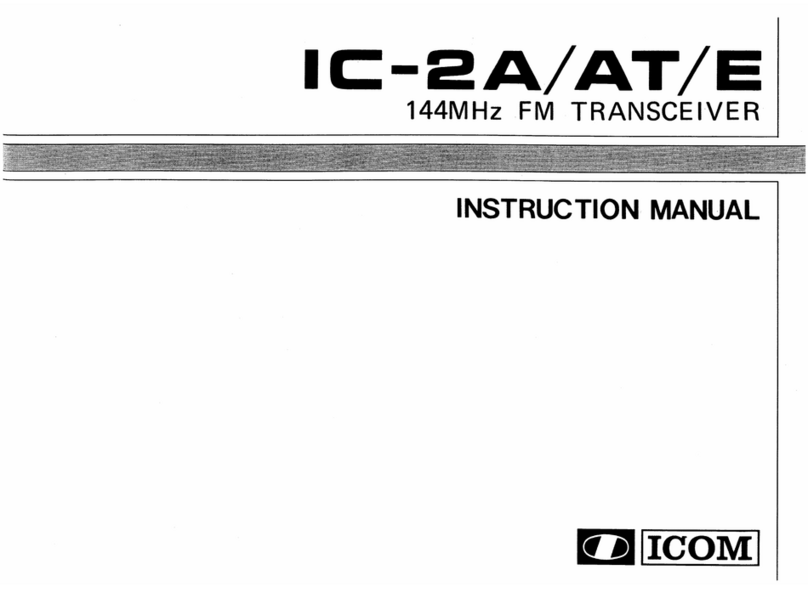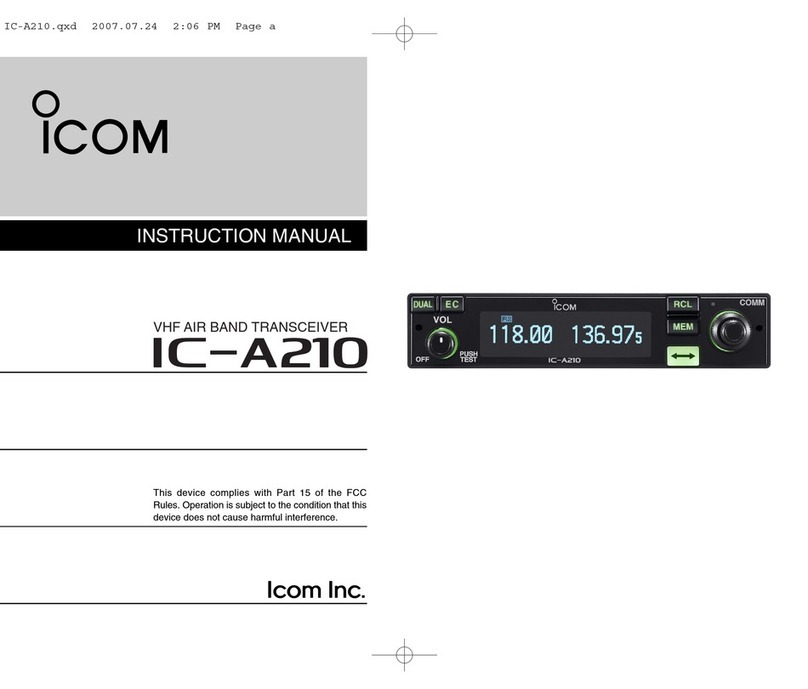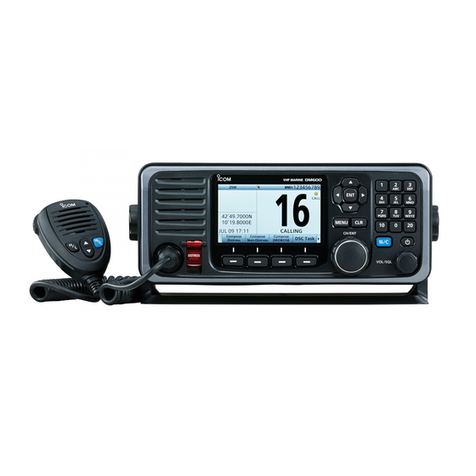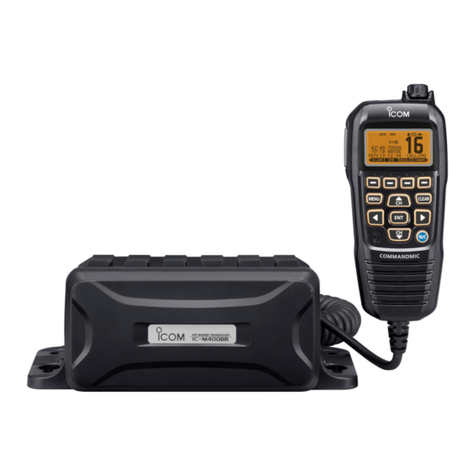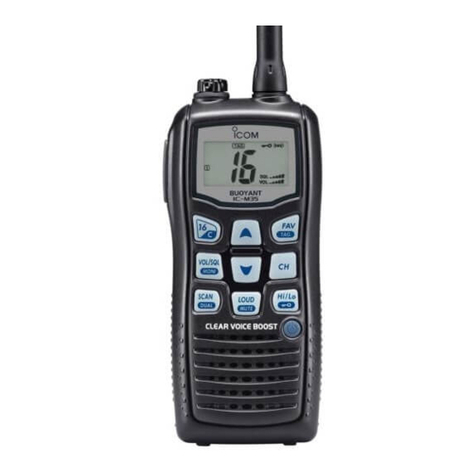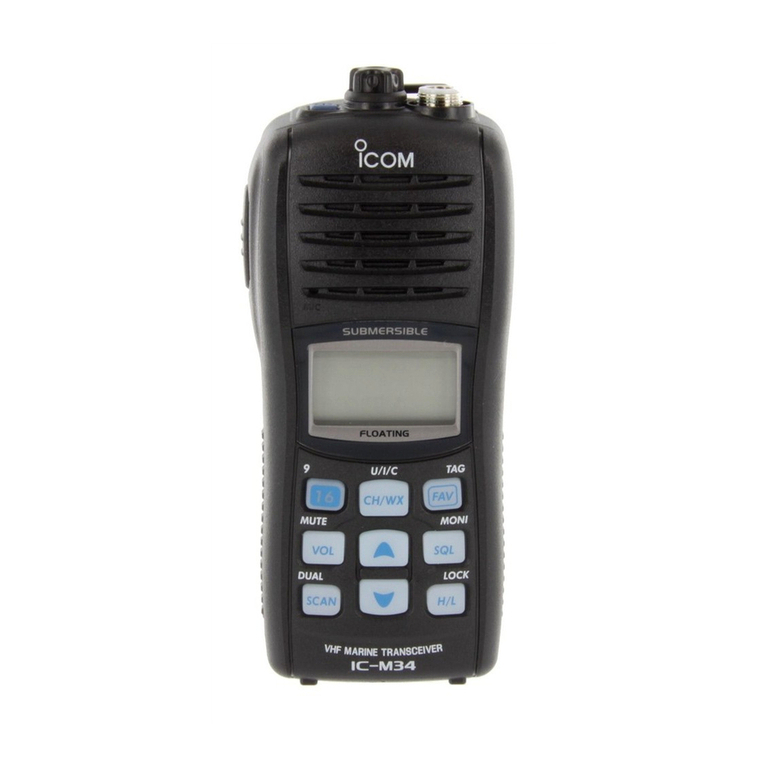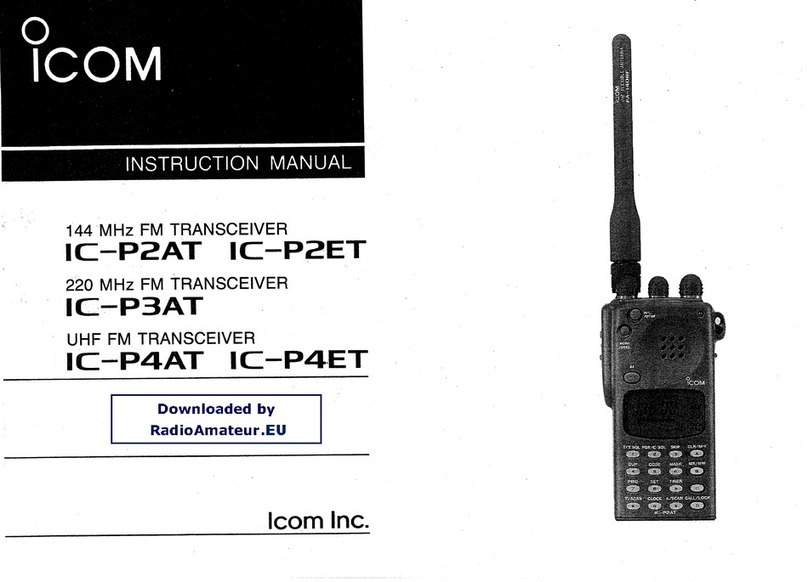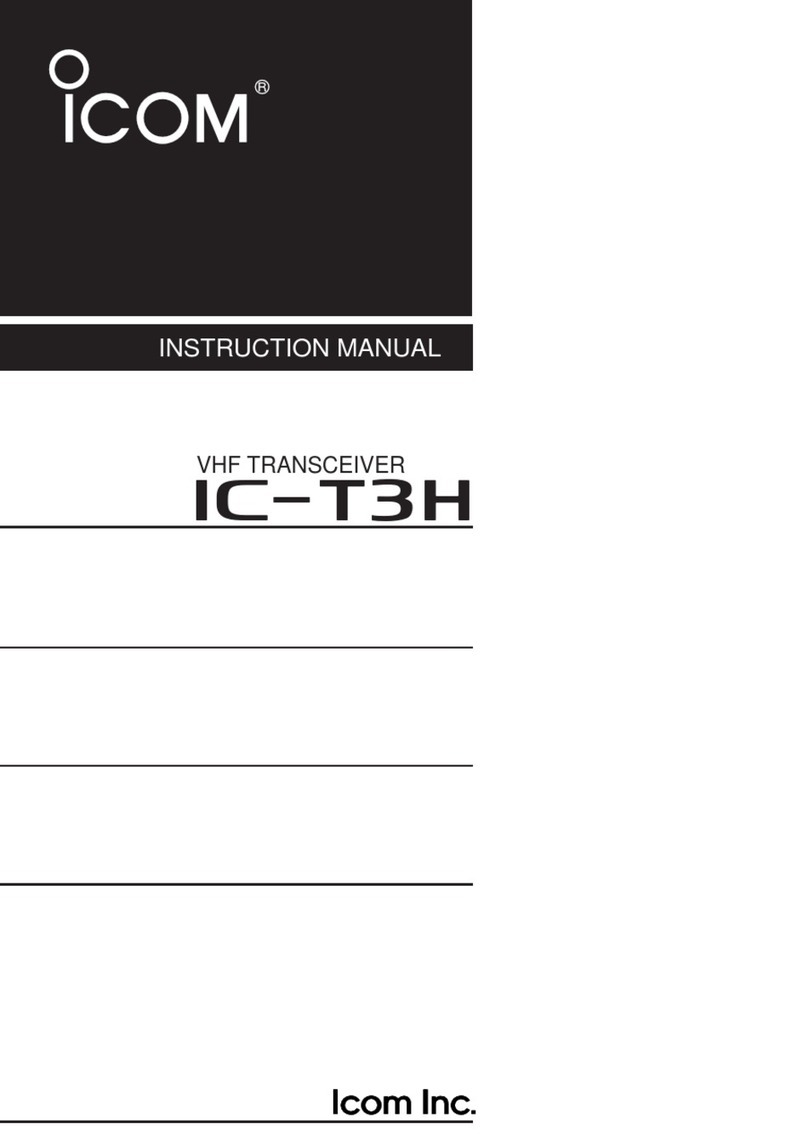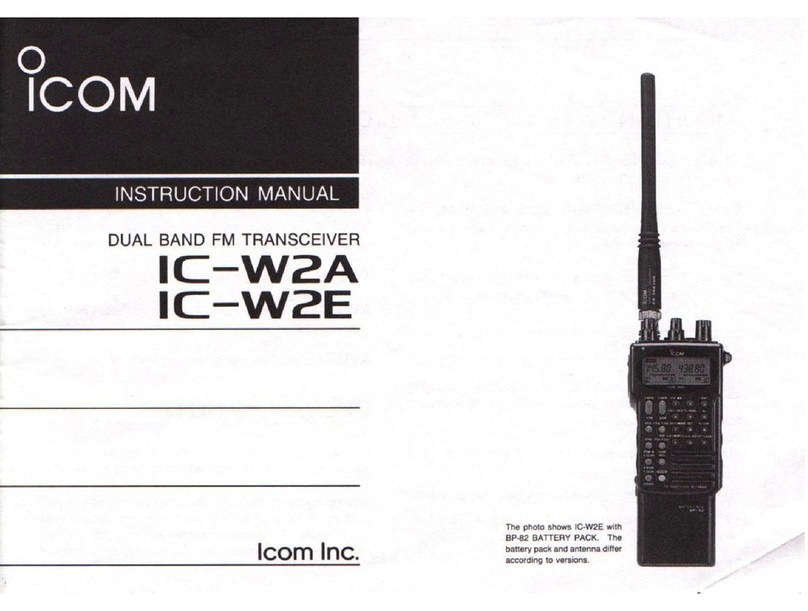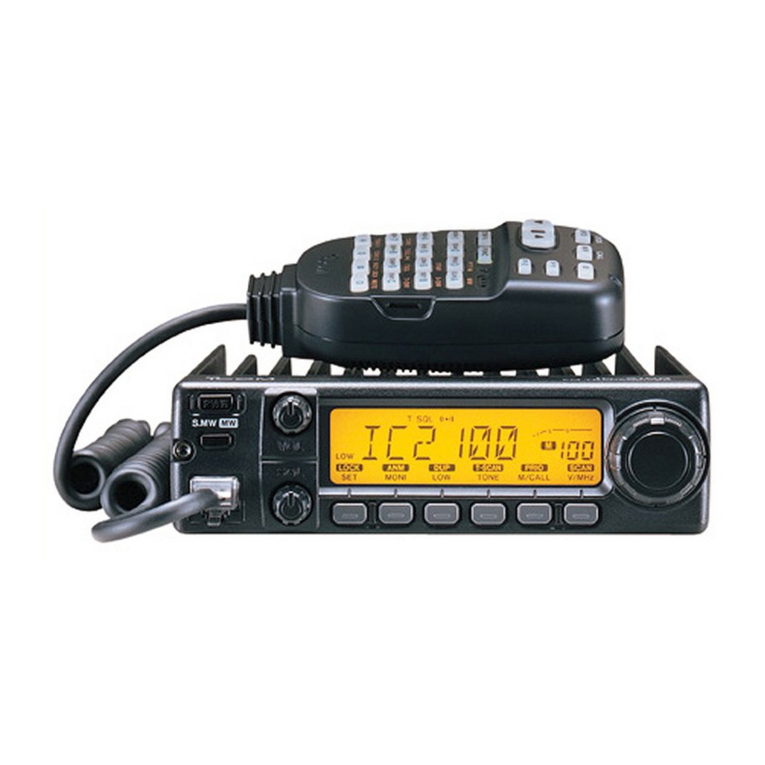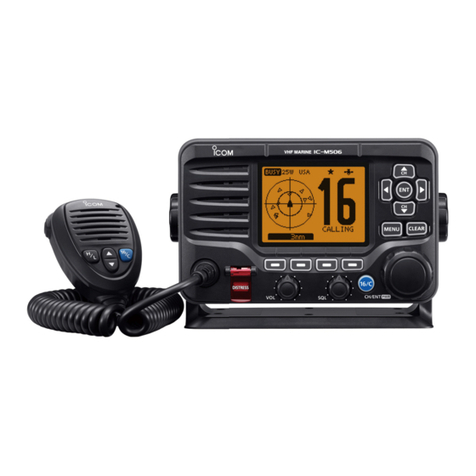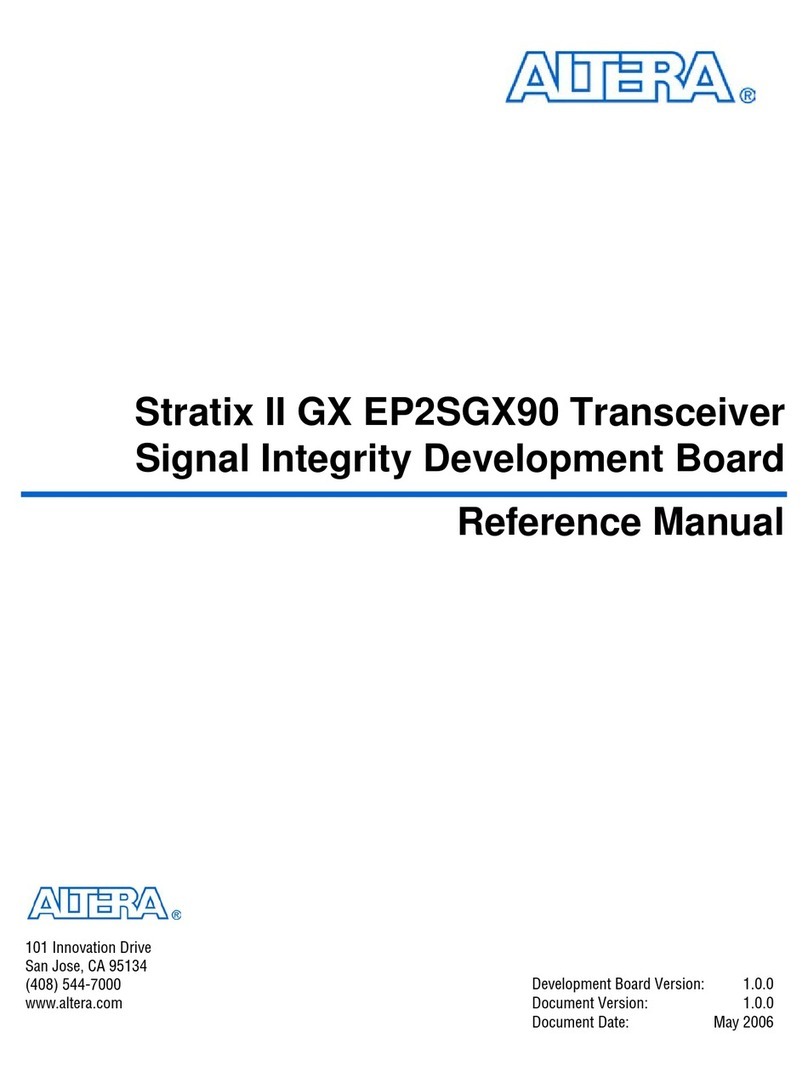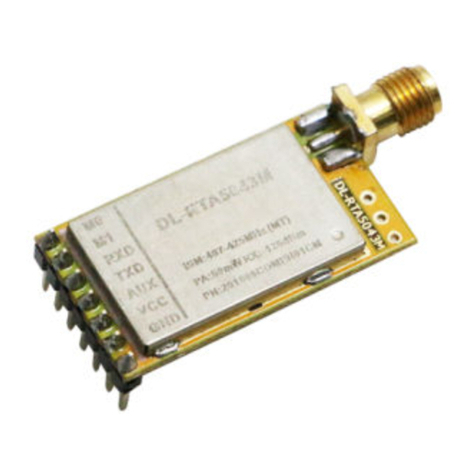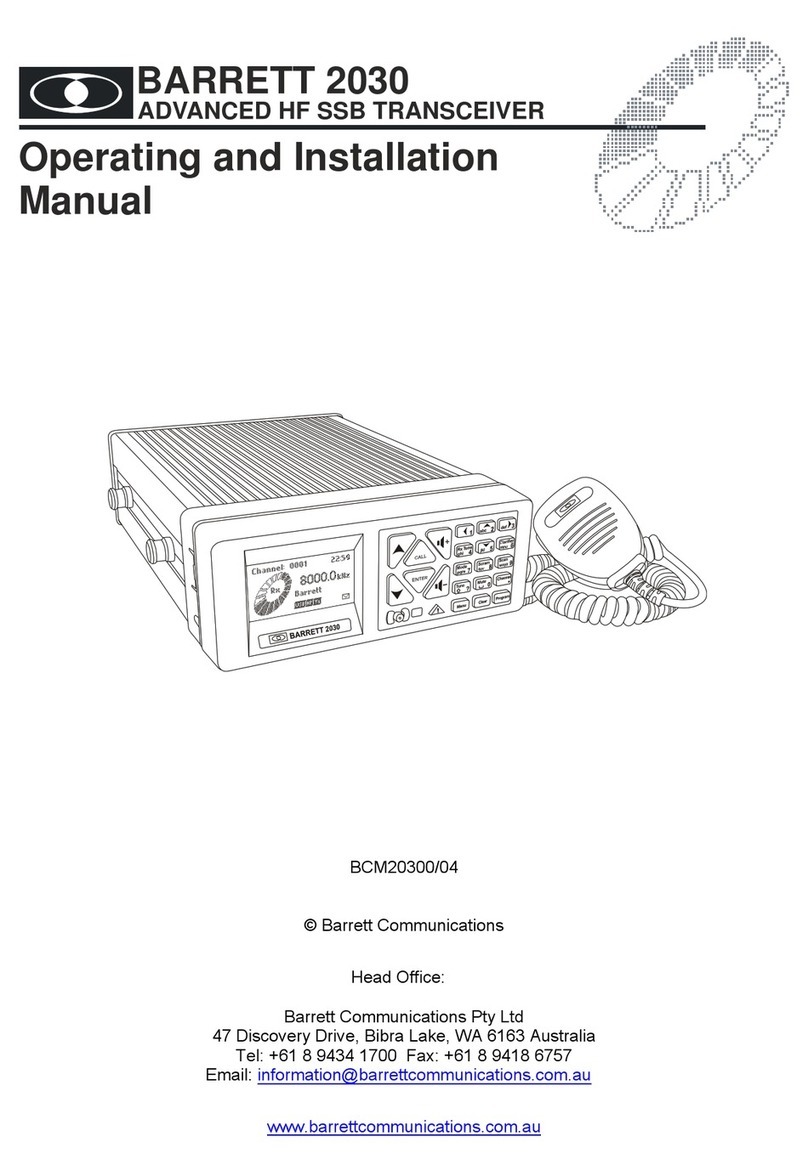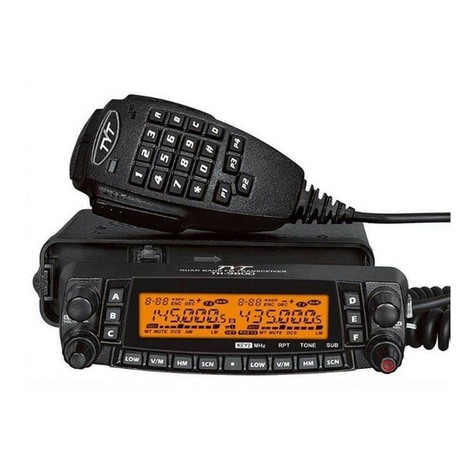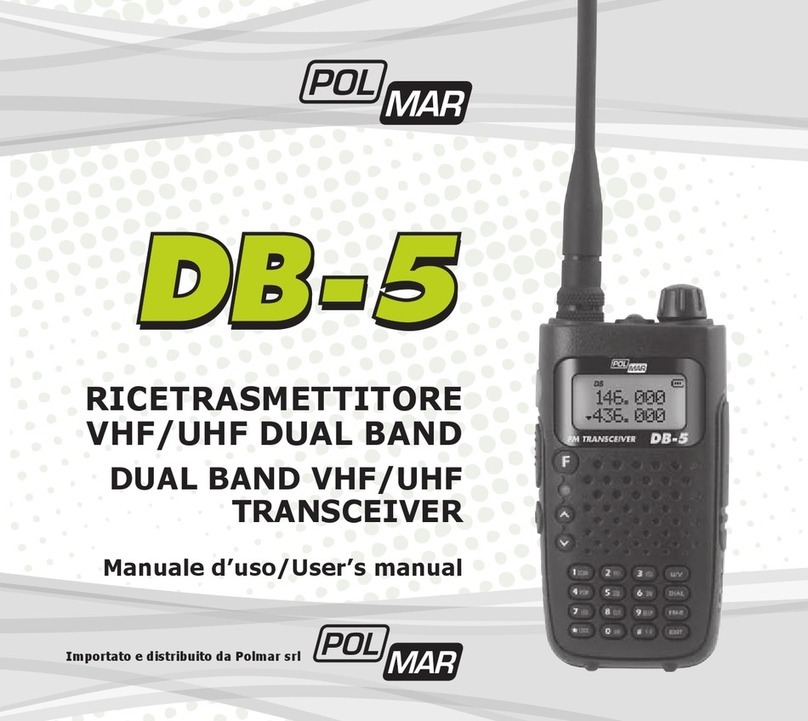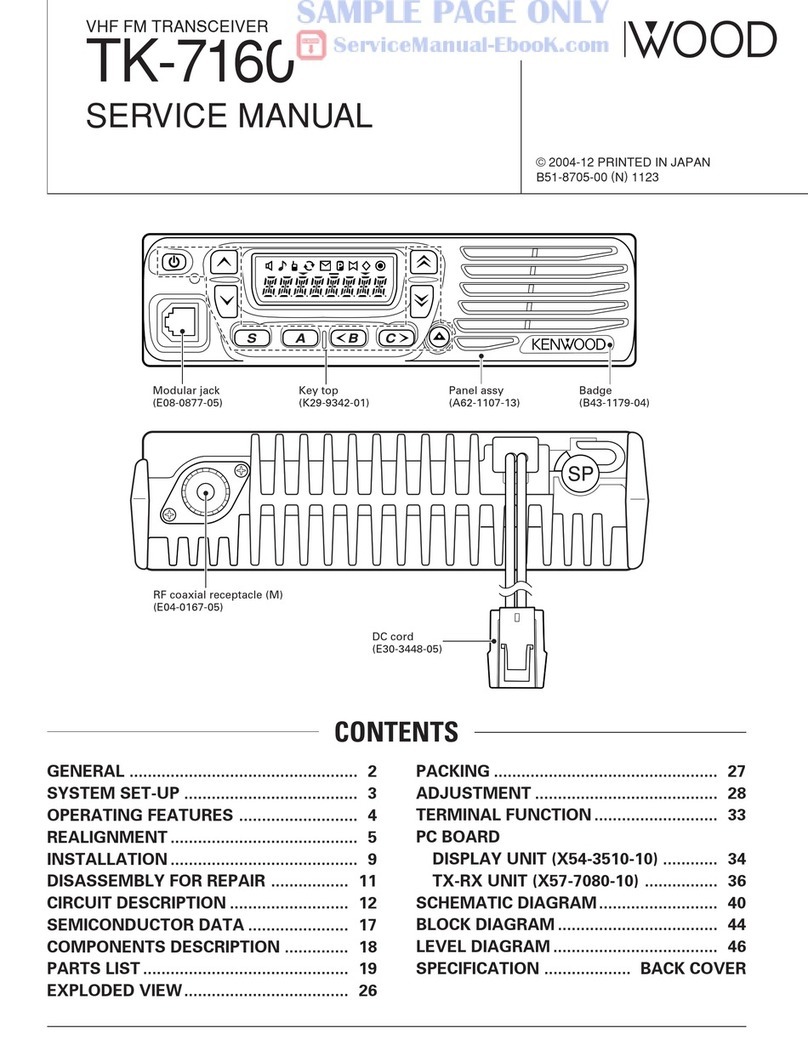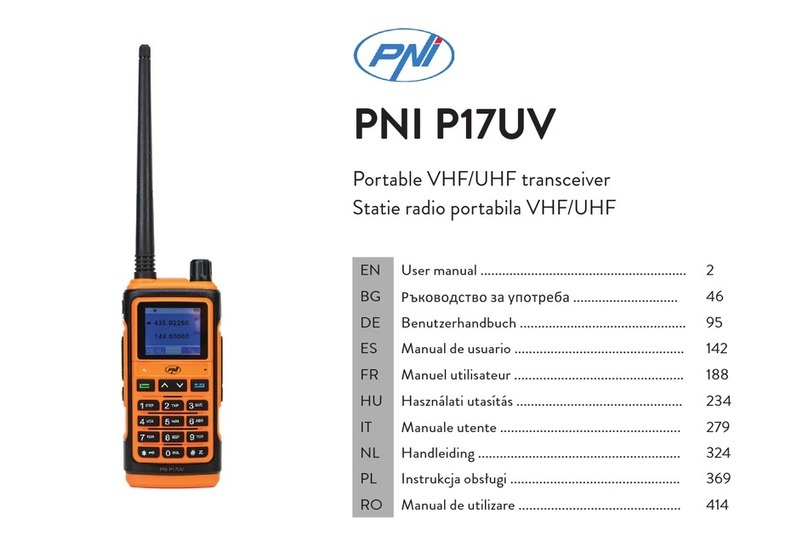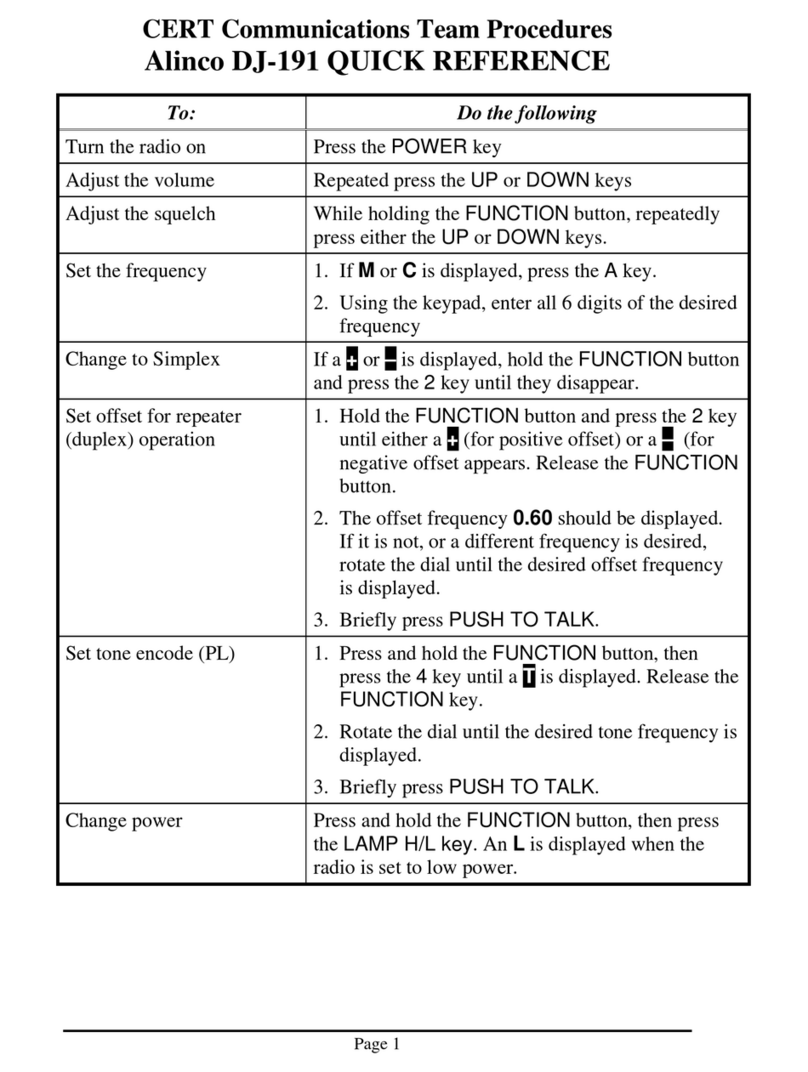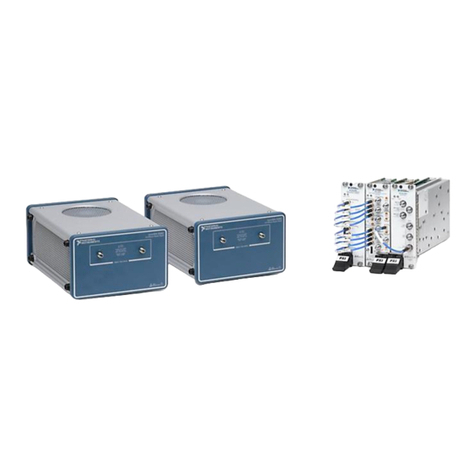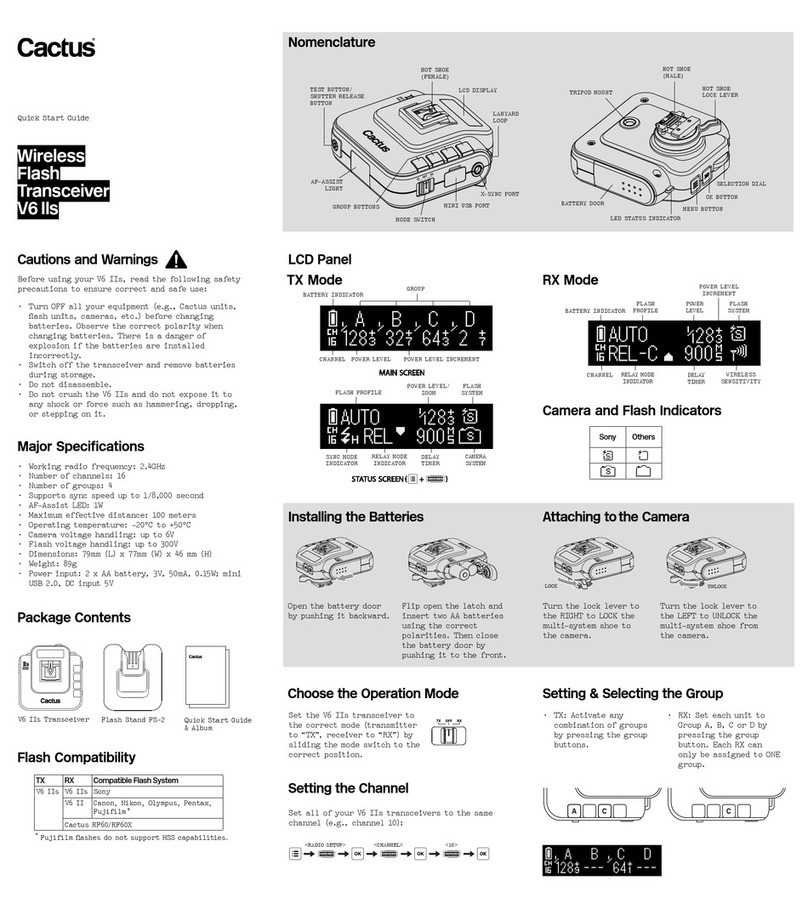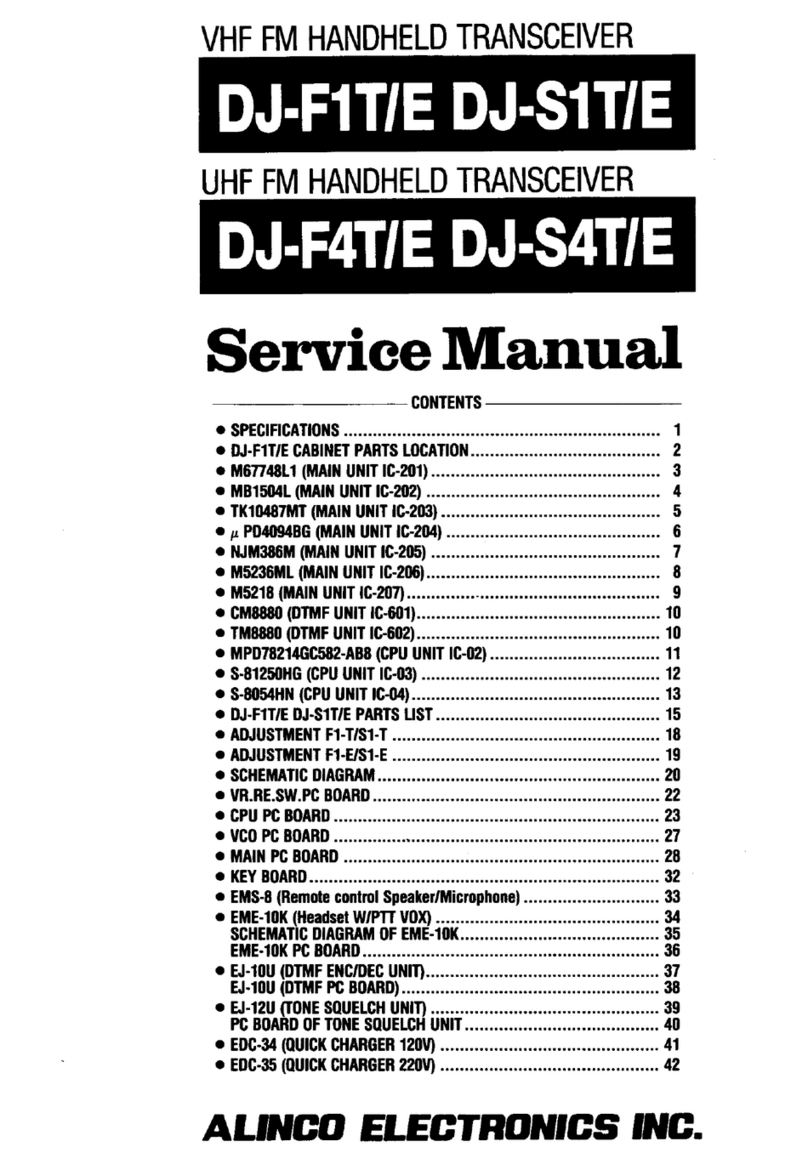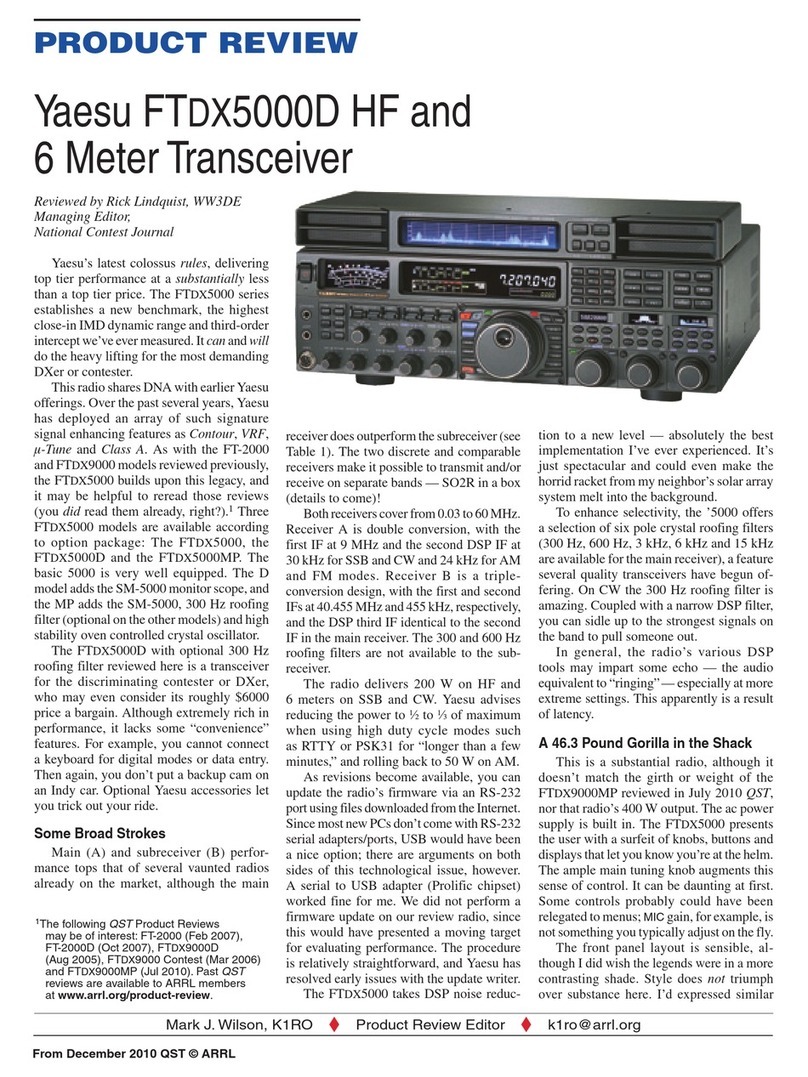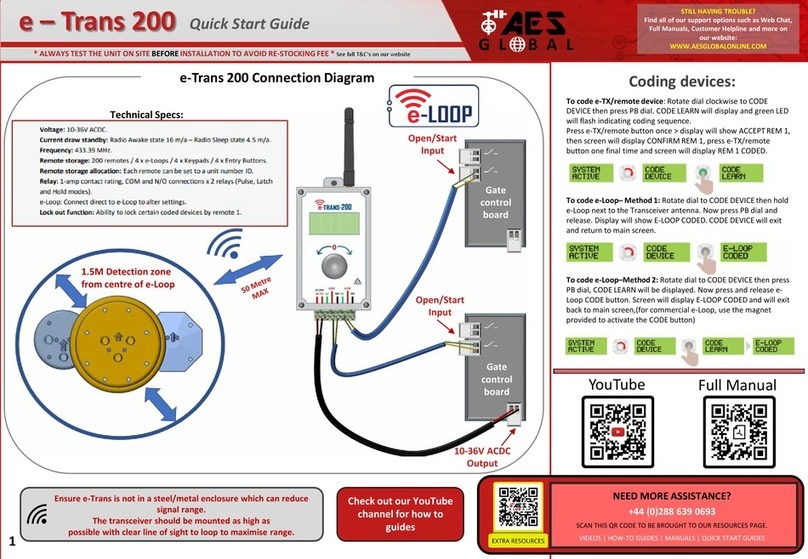Icom IC-V80 User manual

QUICK GUIDE
VHF TRANSCEIVERS
iV80/iV80E
iU80/iU80E
Thank you for purchasing the IC-V80/IC-V80E VHF TRANSCEIVERS
or IC-U80/IC-U80E UHF TRANSCEIVERS with Icom’s state of
the art technology.
Please read all instructions carefully before using.
■Panel description— Front panel
■Precautions
RDANGER! USE the battery only with the transceiver
for which it is specified. Never use a battery with any other
equipment, or for any purpose that is not specified in the in-
struction manual.
RDANGER!
NEVER short the terminals
of the bat-
tery pack.
RWARNING RF EXPOSURE! This device emits
Radio Frequency (RF) energy. Caution should be observed
when operating this device. If you have any questions regarding
RF exposure and safety standards, please refer to the Federal
Communications Commission Office of Engineering and Tech-
nology’s report on Evaluating Compliance with FCC Guidelines
for Human Radio Frequency Electromagnetic Fields (OET Bulle-
tin 65).
RWARNING!
NEVER hold the transceiver so that the
antenna is very close to, or touching exposed parts of the body,
especially the face or eyes, while transmitting. The transceiver
will perform best if the microphone is 5 to 10 cm (2 to 4 inches)
away from the lips and the transceiver is vertical.
RWARNING! NEVER operate the transceiver with
a headset or other audio accessories at high volume levels.
Hearing experts advise against continuous high volume op-
eration. If you experience a ringing in your ears, reduce the
volume level or discontinue use.
RWARNING! NEVER operate the transceiver while
driving a vehicle. Safe driving requires your full attention—
anything less may result in an accident.
RWARNING! NEVER operate or touch the trans-
ceiver with wet hands. This may result in an electric shock or
damage the transceiver.
DO NOT operate the transceiver near unshielded electri-
cal blasting caps or in an explosive atmosphere.
DO NOT push [PTT] when not actually intending to transmit.
BE CAREFUL! The transceiver will become hot when
operating it continuously for long periods of time.
DO NOT use or place the transceiver in direct sunlight or
in areas with temperatures below –20°C (–4°F) or above
+60°C (+140°F).
KEEP the transceiver out of the reach of children.
DO NOT
use harsh solvents such as benzine or alcohol
when cleaning, as they will damage the transceiver's surfaces.
DO NOT disassemble or modify the transceiver. The
transceiver warranty does not cover any problems caused
by unauthorized modification.
KEEP
the transceiver away from heavy rain, and never im-
merse it in the water. The transceiver meets IP54* require-
ments for dust-protection and splash resistance. However,
once the transceiver has been dropped, dust-protection and
splash resistance cannot be guaranteed because of possible
damage to the transceiver’s case or the waterproof seal.
*Only when the battery pack or case, antenna and jack cover are
attached.
Even when the transceiver power is OFF, a slight current
still flows in the circuits. Remove the battery pack or case
from the transceiver when not using it for a long time. Other-
wise, the battery pack or installed dry cell batteries will be-
come exhausted.
This sheet describes only basic operations. For more detailed instructions, go to our web site (URL: http://www.icom.co.jp/world/
index.html) to view or download the full instruction manual.
In the instruction manual, some options or some functions may not be available for your version. Please ask your dealer for details.
■Panel description— Function display
■Belt clip
■Battery cautions
qPTT SWITCH [PTT]
➥Hold down to transmit, release to receive.
For IC-V80E only
➥Quickly push [PTT] once, then immediately hold down
[PTT] again for 1 or 2 seconds, to transmit a 1750 Hz
tone burst signal.
wANTENNA CONNECTOR
Connect an antenna here.
eCONTROL DIAL [VOL]
➥Adjust the volume level.
➥While in the Set mode, or Initial Set mode, rotate to se-
lect a desired item, option or value.
rEXTERNAL SPEAKER/MICROPHONE JACKS [SP MIC]
Accepts an optional speaker-microphone, plug adapter
cable or cloning cable connector. The internal microphone
and speaker will not function when an option is connected.
Be sure to turn OFF the transceiver power, before con-
necting or disconnecting optional equipment to or from
the [SP/MIC] jack.
tMONITOR KEY [MONI]
➥Hold down to temporarily open the squelch to monitor
the operating frequency.
➥While holding down this key, push [Y]or [Z]to adjust
the squelch level.
➥Enters or sends the DTMF code ‘A.’
yPOWER KEY [ ]
Hold down for 1 second to turn the power ON or OFF.
uUP/DOWN KEYS [Y]/[Z]
➥Push to change the operating frequency.
➥During memory mode, push to select a memory channel.
➥While scanning, push to change the scanning direction.
➥
While holding down [MONI], push to adjust the squelch level.
➥While in the Set mode, or Initial Set mode, push to se-
lect a setting item.
➥[Y] enters or sends the DTMF code ‘B.’
➥[Z] enters or sends the DTMF code ‘C.’
iVFO/MEMORY/CALL KEY [VFO/MR/CALL]
➥Push to sequentially select the VFO mode, memory
mode, a Call channel or a weather channel*.
*For only USA version.
➥After pushing [FUNC](M), push to enter the memory
programming mode.
➥After pushing [FUNC](M), hold down for 1 second to
transfer a channel contents to a memory channel, or to
the VFO mode.
➥Enters or sends the DTMF code ‘D.’
DKEYPAD
➥While in the VFO mode, push to enter numbers for frequen-enter numbers for frequen-
cy input.cy input.
➥While in the memory mode, push to enter numbers to selectenter numbers to select
aa memory channel.memory channel.
➥Push to enter or send a DTMF code.
➥
To activate the second function of a key, first push [FUNC](M),
and then push the key.
[1] • [ TONE](1)
➥Numeric input and DTMF code: ‘1’nput and DTMF code: ‘1’
➥After pushing [FUNC](M), selects the Tone function.
[2] • [VOX](2)
➥Numeric input and DTMF code: ‘2’nput and DTMF code: ‘2’
➥After pushing [FUNC](M), turns the VOX function ON
or OFF*.
* Only when an optional headset and plug adapter are con-
nected.
[3] • [T.SCAN](3)
➥Numeric input and DTMF code: ‘3’nput and DTMF code: ‘3’
➥After pushing [FUNC](M), starts a tone scan.
[4] • [DUP](4)
➥Numeric input and DTMF code: ‘4’nput and DTMF code: ‘4’
➥After pushing [FUNC](M), selects minus duplex, plus
duplex, or simplex operation.
[5] • [SCAN](5)
➥Numeric input and DTMF code: ‘5’nput and DTMF code: ‘5’
➥After pushing [FUNC](M), starts a scan.
[6] • [SKIP](6)
➥Numeric input and DTMF code: ‘6’nput and DTMF code: ‘6’
➥After pushing [FUNC](M), sets or cancels the skip
setting.
[7] • [PRIO](7)
➥Numeric input and DTMF code: ‘7’nput and DTMF code: ‘7’
➥After pushing [FUNC](M), starts a priority watch.
[8] • [SET](8)
➥Numeric input and DTMF code: ‘8’nput and DTMF code: ‘8’
➥After pushing [FUNC](M), enters the Set mode.
[9] • [H/M/L](9)
➥Numeric input and DTMF code: ‘9’nput and DTMF code: ‘9’
➥After pushing [FUNC](M), selects the output power
of high, mid or low.
[0] • [DTMF-M](0)
➥Numeric input and DTMF code: ‘0’nput and DTMF code: ‘0’
➥After pushing [FUNC](M), enters the DTMF memory
mode.
[M] • [FUNC](M)
➥DTMF code: ‘DTMF code: ‘M(indication: E)’’
➥Push to access the second function of other keys.
[# ENT] • [ ](# ENT)
➥DTMF code: ‘DTMF code: ‘#(indication: F)’’
➥After entering a frequency, push to save it.
➥Push to exit the Set mode or Initial Set mode.
➥After pushing [FUNC](M), hold down for 1 second to
turn the Key Lock function ON or OFF.
qBUSY ICON
➥Appears when a signal is being received, or the squelch
is open.
➥Blinks while the monitor function is ON.
wSIGNAL ICON
➥Shows the strength of the received signal.
➥While transmitting, shows the output power level.
eTONE ICONS
Appear when the tone function is turned ON, and indicate
which tone function is in use.
rMEMORY ICON
➥Appears when the memory mode is selected.
➥Blinks during a memory scan.
tFREQUENCY READOUT
➥Displays the operating frequency, memory channel, Set
modes contents and a variety of other information.
• The decimal point blinks during a scan.
➥While in the memory mode, the programmed memory
name is displayed.
yBATTERY ICONS
➥“” appears when the battery pack or case is attached.
➥“” appears when the battery is nearing exhaustion.
Charging the battery pack, or replacing the batteries in
the case is necessary.
uKEY LOCK ICON
Appears when the Key Lock function is ON.
iVOX ICON
Appears when the VOX function is ON.
oPOWER ICON
➥“H” appears when high power is selected.
➥“M” appears when mid power is selected.
➥“L” appears when low power is selected.
!0MEMORY CHANNEL NUMBER READOUT
➥Displays the selected memory channel number.
➥“C” appears when the Call channel is selected.
!1AUTO POWER OFF ICON
Appears when the Auto Power OFF function is ON.
!2DUPLEX ICON
➥“+” appears when plus duplex is selected.
➥“–” appears when minus duplex is selected.
• No icon is displayed when simplex is selected.
!3SKIP ICON
Appears when the selected memory channel is set as a
skip channel.
!4FUNCTION ICON
Appears when a second function can be accessed.
!5TRANSMIT ICON
Appears while transmitting.
q
we
r
t
y
u
i
Function
display
Keypad
Microphone
Speaker
u
i
o
q w e r y
t
!5
!4
!3
!1!2 !0
“ ” Repeater tone encoder
“
D
” and “ ” DTCS encoder (Only TX)
“ ” CTCSS squelch function
“
D
” DTCS squelch function
“ ” and “ ” CTCSS Pocket beep function
“” and “
D
” DTCS Pocket beep function
D
For the BP-264 Ni-MH battery
RDANGER! NEVER incinerate used battery packs. Internal
battery gas may cause an explosion.
RDANGER! NEVER immerse the battery pack in water.
If the battery pack becomes wet, be sure to wipe it dry BE-
FORE attaching it to the transceiver.
CAUTION: Always use the battery within the specified tem-
perature range, –5˚C to +60˚C (+23˚F to +140˚F). Using the
battery out of its specified temperature range will reduce the
battery’s performance and battery life.
CAUTION: Shorter battery life could occur if the battery is left
completely discharged, or in an excessive temperature en-
vironment (above +55˚C; +131˚F) for an extended period of
time. If the battery must be left unused for a long time, it must
be detached from the radio after charging. Keep it safely in a
cool dry place at the following temperature range:
–20˚C to +45˚C (–4˚F to +113˚F) (up to a month)
–20˚C to +35˚C (–4˚F to +95˚F) (up to six months)
–20˚C to +25˚C (–4˚F to +77˚F) (up to a year*)
* We recommend charging the battery pack every 6 months.
Clean the battery terminals to avoid rust or bad contact.
Keep battery terminals clean. It’s a good idea to occasionally
clean them.
If your Ni-MH battery pack seems to have no capacity, even
after being charged, completely discharge it by leaving the
power ON overnight. Then, fully charge the battery pack again.
If the battery pack still does not retain a charge (or only very lit-
tle charge), a new battery pack must be purchased.
Prior to using the transceiver for the first time, the battery
pack must be fully charged for optimum life and operation.
• Recommended temperature range for charging:
between +10°C and +40°C (+50˚F to +104˚F) (rapid charge:
with BC-191) or between 0°C and +45°C (+32˚F to +113˚F)
(regular charge: with BC-192)
• Use only the supplied charger or optional charger (BC-191
for rapid charging, BC-192 for regular charging). NEVER
use other manufacturers’ chargers.
The battery pack contains a rechargeable battery.
Charge the battery pack before first operating the transceiver,
or when the battery pack becomes exhausted.
If you want to prolong the battery life, the following points
should be observed:
• Avoid over charging. The charging time period should be
less than 48 hours.
• Use the battery pack until it becomes almost completely ex-
hausted, under normal conditions. We recommend battery
charging just when transmitting becomes impossible.
DFor the BP-265 Li-ion battery
RDANGER! Use and charge only specified Icom battery
packs with Icom radios or Icom chargers. Only Icom battery
packs are tested and approved for use with Icom radios or
charged with Icom chargers. Using third-party or counterfeit
battery packs or chargers may cause smoke, fire, or cause
the battery to burst.
RDANGER!
DO NOT hit or otherwise impact the battery. Do not
use the battery if it has been severely impacted or dropped, or if
the battery has been subjected to heavy pressure. Battery dam-
age may not be visible on the outside of the case. Even if the sur-
face of the battery does not show cracks or any other damage, the
cells inside the battery may rupture or catch fire.
RDANGER! NEVER use or leave battery pack in areas with
temperatures above +60˚C (+140˚F). High temperature buildup
in the battery, such as could occur near fires or stoves, inside
a sun heated car, or in direct sunlight may cause the battery
to rupture or catch fire. Excessive temperatures may also de-
grade battery performance or shorten battery life.
RDANGER! DO NOT expose the battery to rain, snow, sea-
water, or any other liquids. Do not charge or use a wet battery.
If the battery gets wet, be sure to wipe it dry before using.
RDANGER! NEVER incinerate a used battery pack since in-
ternal battery gas may cause it to rupture, or may cause an
explosion.
RDANGER! NEVER solder the battery terminals, or NEVER
modify the battery pack. This may cause heat generation, and
the battery may burst, emit smoke or catch fire.
RDANGER! If fluid from inside the battery gets in your eyes,
blindness can result. Rinse your eyes with clean water, with-
out rubbing them, and see a doctor immediately.
RWARNING! Immediately stop using the battery if it emits an
abnormal odor, heats up, or is discolored or deformed. If any of
these conditions occur, contact your Icom dealer or distributor.
R
WARNING! Immediately wash, using clean water, any part
of the body that comes into contact with fluid from inside the
battery.
R
WARNING!
NEVER put the battery in a microwave oven,
high-pressure container, or in an induction heating cooker.
This could cause a fire, overheating, or cause the battery to
rupture.
CAUTION: Always use the battery within the specified tem-
perature range, –20˚C to +60˚C (–4˚F to +140˚F). Using the
battery out of its specified temperature range will reduce the
battery’s performance and battery life.
CAUTION:
Shorter battery life could occur if the battery is left
fully charged, completely discharged, or in an excessive tem-
perature environment (above +50˚C; +122
˚F
) for an extended
period of time. If the battery must be left unused for a long time,
it must be detached from the radio after discharging. You may
use the battery until the battery icon shows half-capacity, and
then keep it safely in a cool dry place at the following tempera-
ture range:
–20˚C to +50˚C (–4˚F to +122˚F) (up to a month)
–20˚C to +35˚C (–4˚F to +95˚F) (up to three months)
–20˚C to +20˚C (–4˚F to +68˚F) (up to a year)
DCharging caution
RDANGER! NEVER charge the battery pack in areas with
extremely high temperatures, such as near fires or stoves, in-
side a sun-heated vehicle, or in direct sunlight. In such en-
vironments, the safety/protection circuit in the battery will
activate, causing the battery to stop charging.
R
WARNING! DO NOT charge or leave the battery in the
battery charger beyond the specified time for charging. If the
battery is not completely charged by the specified time, stop
charging and remove the battery from the battery charger.
Continuing to charge the battery beyond the specified time
limit may cause a fire, overheating, or the battery may rup-
ture.
R
WARNING! NEVER insert the transceiver (battery at-
tached to the transceiver) into the charger if it is wet or soiled.
This could corrode the battery charger terminals or damage
the charger. The charger is not waterproof.
CAUTION:
DO NOT charge the battery outside of the spec-
ified temperature range: BC-193 (+10˚C to +40˚C; +50˚F to
+104˚F). Icom recommends charging the battery at +20˚C
(+68˚F). The battery may heat up or rupture if charged out of
the specified temperature range. Additionally, battery perfor-
mance or battery life may be reduced.
The supplied battery pack, charger, and AC adapter differ, or
no supplied depending on the version.
Prior to using the transceiver for the first time, the battery
pack must be fully charged for optimum life and operation.
To attach the belt clip:
Slide the belt clip in the direction of the arrow until the belt clip
locks in place, and makes a ‘click’ sound.
To detach the belt clip:
qRemove the battery pack or case from the transceiver, if it
is attached.
wLift the tab up (q), and slide the belt clip in the direction of
the arrow (w).
Belt clip
Battery pack/case
q
w
To attach the battery pack or case:
qFit the battery pack or
case in the direction
of the arrow (q), and
then close it.
wHook the latch until it
makes a ‘click’ sound
(w).
To remove the battery pack or case:
Be careful! The latch is tightly locked, so use caution
when releasing it. DO NOT use your fingernail. Use the
edge of a coin or screwdriver tip to carefully release it.
➥Unhook the latch (z), and
then lift up the battery pack
or case in the direction of
the arrow (x).
w
q
Latch
Battery pac
k
or
battery case
z
x
■Battery pack or case
Low Mid High
Weak RX Signal level Strong
UHF TRANSCEIVERS
NEVER remove or attach the battery pack or case when the transceiver is wet or soiled. This may result in water or dust get-
ting into the transceiver or the battery pack or case, and may result in them being damaged.

A-6795H-1EX-t
Printed in Japan
© 2012 Icom Inc.
1-1-32 Kamiminami, Hirano-ku, Osaka 547-0003, Japan
Printed on recycled paper with soy ink.
■
Memory channels
■Repeater operation
■Scan operation
■Set mode programming ■Initial Set mode programming
DAccessing a repeater
qSet the receive frequency (the repeater output frequency).
• For only USA version:
When the Auto Repeater function is ON, step w and eare not
necessary.
wPush [FUNC](M), and then push [DUP](4) several times to
select minus duplex or plus duplex. ( “–” or “+”)
ePush [FUNC](M), and then push [TONE](1) several times
to turn ON the subaudible tone encoder, depending on the
repeater requirements.
• “ ” appears.
• The subaudible tone frequency can be set in the Set mode.
rHold down [PTT] to transmit.
• The displayed frequency automatically changes to the transmit
frequency (repeater input frequency).
• If “OFF” appears, confirm that the frequency offset is correctly
set.
tRelease [PTT] to receive.
yHold down [MONI] to check whether you can directly re-
ceive the signal from the other station
.
• When the other station’s signal can be directly received, move to
a non-repeater frequency to use simplex. (duplex OFF)
For only USA version:
Auto repeater function uses standard repeater tone fre-
quencies and frequency offsets.
DDuplex operation
• Setting the frequency offset
qPush [FUNC](M), and then push [SET](8) to enter the Set
mode.
wPush [Y]or [Z]to select the frequency offset item.
• “±” and decimal point “.” blink, and the current frequency offset
appears.
eRotate [VOL] to set the desired frequency offset.
• The offset is set in the same step as the frequency tuning step.
• The unit of the frequency offset is “MHz.”
rPush [# ENT] to exit the Set mode.
• Setting the duplex direction
➥Push [FUNC](M), and then push [DUP](4) to select the off-
set direction.
• The “–” (negative offset) or “+” (positive offset) icon appears to
represent the frequency offset direction.
• “–” or “+” blinks when the Reverse Duplex function is ON.
For only USA version:
The Auto Repeater function has priority over the manual
duplex setting. If the transmit frequency changes after set-
ting, the Auto Repeater function may have changed the
duplex setting. Turn the Auto Repeater function OFF to
prevent this.
DReverse Duplex function
When the reverse duplex function is ON, the receive and trans-
mit frequencies are reversed.
q
Push [FUNC](M), and then push [SET](8) to enter the Set mode.
wPush [Y]or [Z]to select the Reverse Duplex function item
(REV).
eRotate [VOL] to turn the function ON or OFF.
rPush [# ENT] to exit the Set mode.
• “–” or “+” blinks when the Reverse Duplex function is ON.
DSubaudible tones
Some repeaters require subaudible tones to access. Subau-
dible tones are superimposed over your normal signal, and
must be set in advance.
q
Push [FUNC](M), and then push [SET](8) to enter the Set mode.
wPush [Y]or [Z]to select the repeater tone item. (rt)
eRotate [VOL] to select the desired subaudible tone fre-
quency.
rPush [# ENT] to exit the Set mode.
DDTCS encoder (Only TX)
The DTCS encoder superimposes the selected DTCS code
over your transmitted signal.
q
Push [FUNC](M), and then push [SET](8) to enter the Set mode.
wSet the DTCS code and polarity, in the same way you set
the DTCS squelch.
• You can set the DTCS transmit and receive polarity, but the
DTCS encoder affects only transmit.
ePush [# ENT] to exit the Set mode.
rPush [FUNC](M), and then push [TONE](1) several times,
until both “
D
” and “ ” appear.
• The DTCS encoder activated.
DTone setting
• DTMF TONES
While holding down [PTT], push the desired DTMF keys, [0]
to [9], [MONI](A), [Y](B), [Z](C), [VFO/MR/CALL](D), [M]
(E), and [# ENT](F), to transmit their assigned DTMF codes.
• 1750 Hz TONE
To access some European repeaters, the transceiver must
transmit a 1750 Hz tone burst.
For IC-V80E only
Quickly push [PTT] once, then immediately hold down [PTT]
again for 1 or 2 seconds.
For other transceivers
While holding down [PTT], hold down either the [Y]or [Z]
for 1 or 2 seconds
.
• Set mode operation
qPush [FUNC](
M
), and then push [SET](8) to enter the Set
mode.
wPush [Y]or [Z]to select a desired item.
eRotate [VOL] to select an option or value.
rPush [# ENT] to exit the Set mode.
The initial Set mode is accessed at power ON, and allows
you to set seldom-changed settings. In this way, you can
“customize” the transceiver to suit your preference and op-
erating style.
• Initial Set mode operation
qWhile holding down [Y]and [Z], hold down [ ] for 1 sec-
ond to enter the Initial Set mode.
wPush [Y]or [Z]to select a desired item.
eRotate [VOL] to select an option or value.
rPush [# ENT] to exit the initial Set mode.
DScan types
DProgrammed scan
Repeatedly scans between two programmed frequencies
(memory channels “xA” and “xb”). Used to check for frequen-
cies within a specified range, such as repeater output frequen-
cies, and so on. 3 pairs of scan edges are programmable.
NOTE: Scan edge channels, 1A/b, 2A,b and 3A/b must be
programmed in advance. Program them in the same man-
ner as regular memory channels.
If identical frequencies are programmed into the scan
edge channels, the programmed scan will not function.
qPush [VFO/MR/CALL] several times to select the VFO
mode.
w
Push [FUNC](M), and then push [SCAN](5) to start the scan.
eDuring the scan, push [FUNC](M), and then push [SET](8)
several times to select either the “P1,” “P2,” “P3” or “AL”
scan.
• “AL” for band edge to band edge scan.
• “P1,”“P2” and “P3” for programmed scan between the programmed
scan edge channels.
• To change the scan direction, push [Y]or [Z].
rTo cancel the scan, push any key except [ ], [Y]/[Z],
[MONI] or [FUNC](M).
DMemory Scan
Repeatedly scans memory channels, except those set as
skip channels, described in the next scan topic.
qPush [VFO/MR/CALL] several times to select the memory
mode.
• “X” appears.
w
Push [FUNC](M), and then push [SCAN](5) to start the
scan.
• To change the scan direction, push [Y]or [Z].
eTo cancel the scan, push any key except [ ], [Y]/[Z],
[MONI] or [FUNC](M).
DSetting skip channels
The memory skip function speeds up scanning by not scan-
ning those memory channels set as skip channels. Set skip
channels as follows.
qPush [VFO/MR/CALL] several times to select the memory
mode.
wPush [Y]or [Z]to select the memory channel to be
skipped.
ePush [FUNC](M), and then push [SKIP](6) to set the chan-
nel as skip channel.
•
“SKIP” appears.
DScan resume setting
Various pause and timer options can be selected with the Scan
Resume function. The selected resume option is also used for
Priority Watch, described below.
DPriority watch
• Memory or Call channel watch
While operating on a VFO frequency, Priority Watch checks for
a signal on the selected memory or Call channel every 5 sec-
onds.
qSelect the VFO mode, and then set the operating frequency.
wPush [VFO/MR/CALL] several times to select the memory
mode or Call channel mode.
• For memory channel watch:
Push [Y]or [Z]to select a desired memory channel.
e
Push [FUNC](M), and then push [PRIO](7) to start the
watch.
• The decimal point “.”, on the frequency readout blinks.
• When a signal is received on the channel, the watch resumes ac-
cording to the selected scan resume option.
rTo cancel the watch, push any key except [ ], [Y]/[Z],
[MONI], [FUNC](M), or [PTT].
• Memory scan watch
While operating on a VFO frequency, Priority Watch sequential-
ly checks for signals on each memory (except Skip) channel.
qSelect the VFO mode, and then set the operating frequency.
wPush [VFO/MR/CALL] several times to select the memory
mode.
ePush [FUNC](M), and then push [SCAN](5) to start the
memory scan.
rPush [FUNC](M), and then push [PRIO](7) to start the
watch.
• The VFO mode is selected, and the decimal point “.”, on the fre-
quency readout blinks.
• When a signal is received on a channel, the watch resumes ac-
cording to the selected scan resume option.
tTo cancel the watch, push any key except [ ], [Y]/[Z],
[MONI], [FUNC](M), or [PTT].
DMemory channel programming
q
Push [VFO/MR/CALL] several times to select the VFO mode.
wSet the desired frequency.
➥If desired, set other data (e.g. frequency offset, duplex
direction, tone squelch, and so on.).
ePush [FUNC](M), and then push [VFO/MR/CALL].
• “X” and the memory channel number blink.
• Select the Call channel mode to program the Call channel.
rPush [Y]or [Z]to select the memory channel to be pro-
grammed.
• Select “1A/1B” to “3A/3B” to program a scan edge channel.
tPush [FUNC](M), and then hold down [VFO/MR/CALL] for
1 second to program.
• 3 beeps sound.
• If you continue to hold down [VFO/MR/CALL] for 1 second after
programming, the memory channel number automatically in-
creases.
NOTE: To cancel programming, push [VFO/MR/CALL] be-
fore doing step t.
DSelecting a memory channel
• Using [Y] or [Z]
qPush [VFO/MR/CALL] several times to select the memory
mode.
• “X” appears.
wPush [Y]or [Z]to select the desired channel.
• Only programmed channels are displayed.
• Using the keypad
qPush [VFO/MR/CALL] several times to select the memory
mode.
• “X” appears.
wTo select the desired channel, enter the 3 digits of the
channel number using the keypad.
• Blank channels are also selectable.
• Entering one or two digits, and then pushing [# ENT] also se-
lects a 1 or 2 digit memory channel, respectively.
DSelecting the Call channel
➥Push [VFO/MR/CALL] several times to select the Call
channel.
• “C” appears instead of the memory channel number.
PROGRAMMED SCAN
The Programmed scan P1 scans between 1A and 1b, P2 scans be-
tween 2A and 2b, and P3 scans between 3A and 3b frequencies.
Band
edge Band
edge
1A
2A
3A
1b
2b
3b
Scan edges
Scan
Jump
MEMORY (SKIP) SCAN
SKIP SKIP
Mch 1
Mch 0
Mch 2 Mch 3 Mch 4 Mch 5
Mch 10
Mch 199
Mch 9 Mch 8 Mch 7
Mch 6
PRIORITY WATCH
• Memory/Call channel watch • Memory scan watch
5 seconds
VFO
frequency
Memory
(Call)
channel
5 seconds
VFO
frequency
SKIP
Mch 0
Mch 1
Mch 2
Mch 199
Set the microphone sensitivity.
Set the VOX Delay.
Set the VOX time-out timer.
To turn OFF the function, select “Vto.OF.”
Select the method to transmit
a DTMF code sequence.
Set the operating mode to FM or FM-N.
Select the subaudible tone
needed to access the repeater.
Select the CTCSS tone frequency
for tone squelch.
Set the DTCS code for
DTCS squelch and DTCS encoder.
Set the Transmit
and Receive DTCS polarity.
Set the duplex frequency offset.
Turn the Reverse Duplex function
ON or OFF
Select the VFO tuning step.
Set the time between when the Function
mode is entered, and how long it remains
activated after you push the keypad key
to activate its second function.
Select the LCD Backlight function.
Turns the TX Inhibit function ON or OFF.
Turn the Weather Alert function ON or OFF.
Set the VOX gain.
To turn OFF the VOX function, select “VOX.OF.”
• LCD backlight
• Function key timer
Set mode items
• TX permission
• Weather alert (For only USA version)
• Repeater tone frequency
• Tone squelch frequency
• DTCS code
• DTCS polarity
• Frequency offset
• Tuning step
• Reverse duplex function
• Scan resume setting
Select the scan pause and resume setting.
• VOX time-out timer
• Operating mode
• MIC gain
• VOX delay
• DTMF TX key
• VOX gain
:
:
NOTE: When the display type setting is set to “CH” in the Initial
Set mode, and accessing the Set mode from the memory
mode, most of the Set mode items do not appear.
Initial Set mode items
:
:
• Key-touch beep
Turns the key-touch beep ON
(Set the beep level 1 to 3) or OFF.
Inhibit continuous transmissions
longer than the selected time period.
Automatically turns OFF
the transceiver’s power.
Turn the Lockout function ON or OFF.
Set the squelch delay to Short or Long.
Select the display type for memory
mode operation.
• Time-out timer
• Auto power OFF
• Lockout
• Squelch delay
• Dial assignment
Set the DTMF sending rate.
Select whether or not to use [VOL] as
the tuning control instead of [Y] and [Z].
Select the LCD contrast.
Select the ratio of the power save time
to the standby time.
Selects whether or not to accelerate
the step speed when rotating
[VOL] rapidly.
Turns the Auto Low Power function
ON or OFF.
Select the Microphone mode.
Select the protection option
according to your battery type.
• DTMF speed
• Display type
• LCD contrast
• Power save
• Select speed
• Microphone simple mode
• Battery protection function
• Auto low power
Turns the Squelch Burst function
ON or OFF.
• Squelch burst (For only IC-U80/IC-U80E)
Turns the Auto Repeater function
ON or OFF.
• Auto repeater (For only USA version)
Basic operation■
D Turning power ON/OFF
➥Hold down [ ] for 1 second to turn the power ON or OFF.
D Mode selection
The transceiver has 2 basic operating modes; VFO mode and
memory mode.
➥Push [VFO/MR/CALL] several times to sequentially select
the VFO mode, memory mode, Call channel mode and
weather channel mode*.
*For only USA version.
DSetting a frequency
• Using [Y] or [Z]
qIf necessary, push [VFO/MR/CALL] several times to select
the VFO mode.
wPush [Y]or [Z]to set a frequency.
• The frequency changes according to the selected tuning
step.
• Using the keypad
qIf necessary, push [VFO/MR/CALL] several times to select
the VFO mode.
wTo enter the desired frequency, enter 6 digits, starting from
the 100 MHz digit.
• Entering two or three* to five digits, and then pushing [# ENT],
also sets the frequency. (*Depending on the transceiver version)
• If the entered frequency is outside of the frequency range, the
previously displayed frequency is automatically recalled.
DTuning step selection
The transceiver has 8 tuning step options;
• 5 kHz • 10 kHz • 12.5 kHz • 15 kHz
• 20 kHz • 25 kHz • 30 kHz • 50 kHz
The tuning step can be selected in the Set mode.
qPush [FUNC](
M
), and then push [SET](8) to enter the Set
mode.
wPush [Y]or [Z]to select the tuning step item (tS).
eRotate [VOL] to select the desired tuning step.
rPush [# ENT] to exit the Set mode.
DKey Lock function
Use the Key Lock function to prevent accidental frequency or
channel change and unnecessary function access.
➥Push [FUNC](
M
), and then hold down [](# ENT) for
1 second to turn the Key Lock function ON or OFF.
• “ ” appears while the Key Lock function is ON.
• [ ], [VOL], [MONI], [PTT] and [FUNC](M)+ [](# ENT) are
still operable while the Key Lock function is ON.
DMonitor function
This function is used to listen to weak signals, or to manually
open the squelch.You can use it without disturbing the squelch
setting, even when mute functions such as the tone squelch
are in use.
➥Hold down [MONI] to open the squelch.
• Release [MONI] to cancel the function.
DAdjusting the squelch level
➥While holding down [MONI], push [Y]or [Z]several times
to adjust the squelch level.
• “SqL 1” is loose squelch (for weak signals) and “SqL10” is tight
squelch (for strong signals). “SqL 0” is open squelch.
DSelecting output power
Set the output power level to suit your operating requirements.
Lower output powers during short-distance communications
may reduce the possibility of interference to other stations and
will reduce current consumption.
➥Push [FUNC](
M
), and then push [H/M/L](9) several times to
select the output power.
• “ H,” “M,” or “ L” appears, depending on the selected output power.
[1]•[ TONE]
[PTT]
[2]•[VOX]
[3] • [T.SCAN]
[MONI]
[ ]
[4]•[DUP]
[5]•[SCAN] [6]•[SKIP]
[VOL]
[VFO/MR/CALL]
[7]•[PRIO] [8]•[SET] [9]•[H/M/L]
[0]•[DTMF-M] [# ENT]•[ ]
If you want to reset the VFO frequency, VFO settings and Set
mode items to their default values, without clearing the mem-
ory contents, you can do a partial reset of the transceiver's
CPU.
qHold down [ ] for 1 second to turn OFF the power.
wWhile holding down [VFO/MR/CALL], hold down
[]for 1 second to turn ON the power.
• The CPU will partially reset.
■
Partial reset
Other manuals for IC-V80
3
This manual suits for next models
3
Table of contents
Other Icom Transceiver manuals

Icom
Icom IC-M57 User manual
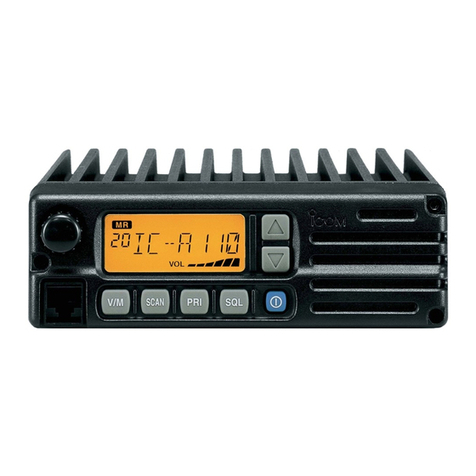
Icom
Icom IC-A110 User manual
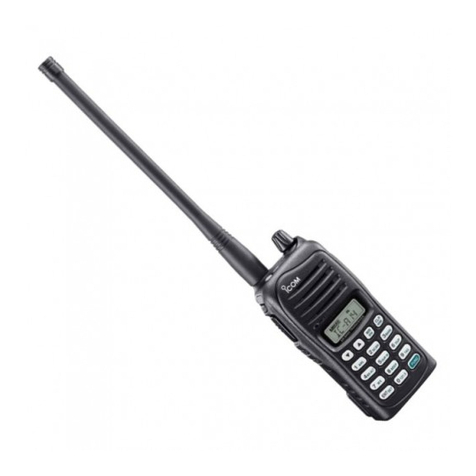
Icom
Icom IC-A14 User manual
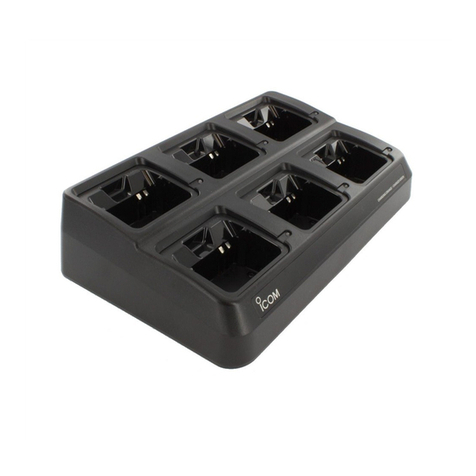
Icom
Icom DC-197 Installation and operating instructions
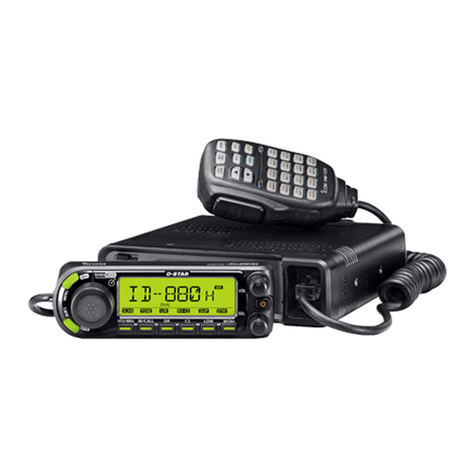
Icom
Icom ID-880H User manual

Icom
Icom IC-F5122D User manual
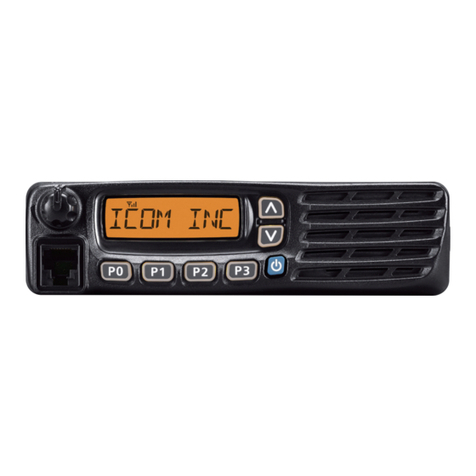
Icom
Icom IC-F6121D-51B User manual

Icom
Icom IC-A210E User manual
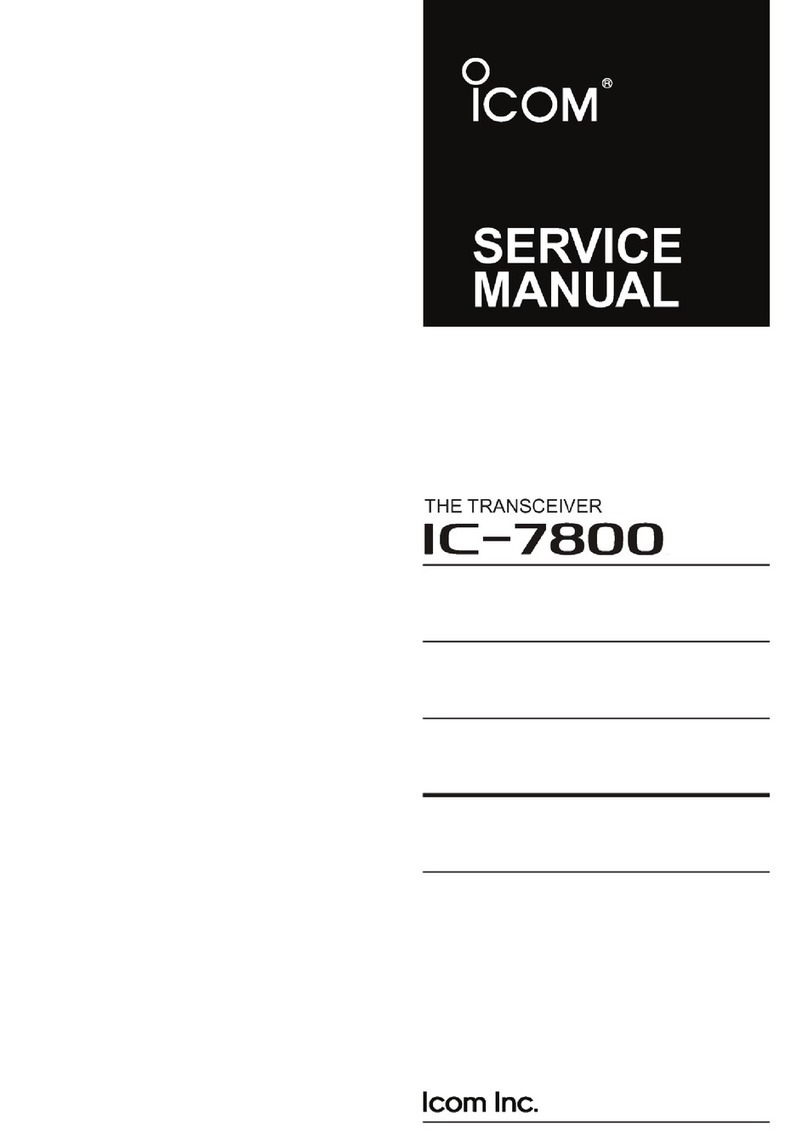
Icom
Icom IC-7800 User manual
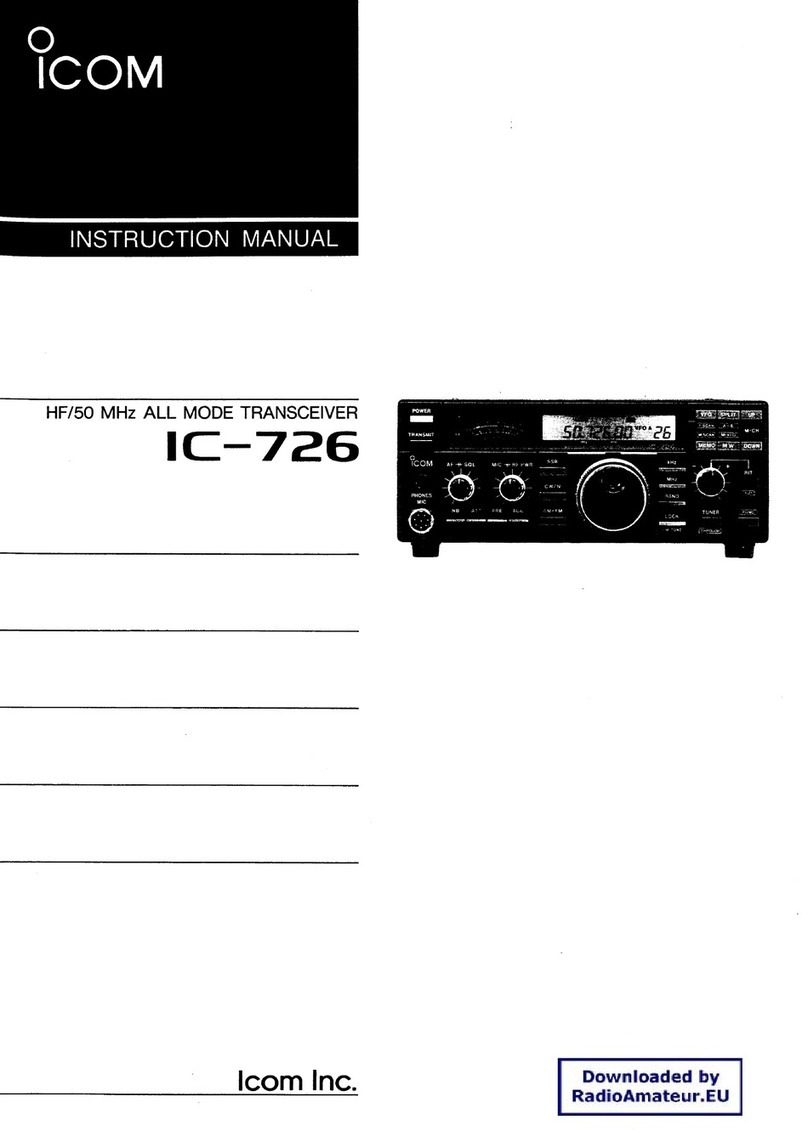
Icom
Icom IC-726 User manual

